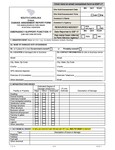


The farmers gathered Oct. 16 at the Barn House Restaurant in Lake City were looking to get some good news on the flooding that caused what state Agriculture Secretary Hugh Weathers estimated is at least $300 million in damages to row crops.
But good news was not forthcoming at the meeting, which was moderated by East Clarendon High School FFA teacher Bert Beasley.
“You need to call your adjuster first of all before you do anything to your crop,” said ArborOne Farm Credit representative Ashley Altman. The company insures farms in seven South Carolina counties, including Clarendon.
“We need your adjustor to look at it before you even attempt to harvest what’s left because we don’t know what’s out there,” Altman said.
Clarendon County Clemson Extension Agent Hannah Mickell said Clarendon County farmers will see “almost a total loss, no matter what the crop.”
Mickell and other agents were handing out damage assessment report forms to farmers at the Oct. 16 meeting. Holding one of the forms she was handed that night, she said Clarendon’s situation is “dire.”
“On this form right here, if I was to read it right now, I bet he’s lost a few million dollars at least, just this one guy,” Mickell said. “I talked to another guy (Oct. 16) who at least lost $2 million, and he only farms 2,500 to 3,000 acres.”
She said soybeans are currently “rotting in the field.”
“There’s different groups of beans,” she said. “Early beans will rot in the field. You couldn’t even get out there to harvest them. The late beans will have maturity problems, so they won’t mature on time and they will also likely rot in the field.”
Peanuts and cotton are in even worse shape, Mickell said. Cotton farmers, she noted, get paid for the seed inside the boll and also the lint, which is the cotton itself.
“Whenever it got so wet, the seed in the cotton boll sprouted, so you can knock out getting paid for that,” Mickell said. “The water also weakened the lint’s strength, so you’re going to have a hard time getting payment for that.”
And once the sun came out Oct. 6 after nearly four days of non-stop rain, cotton began “re-growing” where it had already been tragically defoliated.
“And that makes for trashy cotton,” Mickell said. “So, now you’ve got cotton you’re not going to get paid seed on, cotton that’s just not going to pick well for the lint, rotten cotton and what is there will be tinted or trashy. It’s a big mess all the way around.”
Clemson Extension Director Dr. Thomas Dobbins said it will be “several months before we know the extent of the total damage across the state.”
Meherrin spokesman Randal Morris said that’s why farmers should heed Altman’s advice and get with insurance adjusters are soon as possible.
“Document profitability and expense,” he said.
Representatives from both offices for U.S. Rep. Jim Clyburn and U.S. Sen. Lindsey Graham said it will take a literal “act of Congress” for South Carolina farmers to get federal aid that doesn’t consist of more loans.
“And any bill that could possibly get through to help you, it would likely be until January until that would even be possible,” said Graham Pee Dee District Director Celia Urquhart.
“When Hurricane Sandy happened to New Jersey, it was about this same time,” Urquhart said. “It was about January or February until they had some federal aid through Congress.”
Urquhart fielded a farmer’s question about Graham’s rejection of aid to Hurricane Sandy victims.
“It was a $61 billion bill,” Urquhart said. “And $21 billion of it was completely not related to Sandy relief. It was pork. Sen. Graham will have a clean bill to help South Carolina with funds dedicated solely to relief where it’s needed most.”
Clyburn’s representative, Kenneth Barnes, said the state’s legislative delegation will have a hard time getting any aid bills passed for the beleaguered state.
“Our legislative delegation is a small size,” he said. “And when they try to get stuff for farmers, you have states that don’t do a lot of farming, and those representatives and senators don’t understand.”
Barnes urged farmers to document their losses not only by registering with insurance companies, the U.S. Department of Agriculture, the Federal Emergency Management Agency and other organizations, but also by photographing damaged crops, equipment and infrastructure.
“We need those pictures,” Barnes said. “We need those pictures to show in Washington, D.C., to those who don’t understand.”
Cag Brunson of Oak 3 Farms in Summerton is one farmer worried about recouping losses from damaged produce, which he said isn’t typically insured against flood or weather issues.
“Produce is a crop that you don’t really have insurance on,” he said. “You can insure row crops, like what we have here: soybeans, corn and wheat. Those losses don’t bother me as much, because you can insure them.”
Mikell said farmers register their crops with the Farm Service Agency, and then insure against losses like the recent flood.
“So, let’s say they’re going to grow 1,000 acres of cotton; they would go and register that, and then insure say up to 75 percent,” she said. “So, when something terrible happens to that crop and you can’t use it, you’re hopeful that your insurer will declare it a total loss and at least pay so you can break even.”
Mickell said the insurance payment, if granted, would not cover “cost of living or paying workers or subcontractors.”
“It would literally just help you break even,” she said. “And we’ve got a lot of farmers in that situation right now, just hoping to break even.”
Harry DuRant of Double D Farms said his wife told him the yard at their farm was filling with water about 2 a.m. Oct. 4, about the time deputies in Clarendon County began evacuating Summerton residents inundated by flood waters.
“I looked at our digital rain gauge and it zeroes out at 12 o’clock. It was on its way to 16 inches in one day, though I didn’t know that at the time,” DuRant said.
DuRant tried that Sunday morning to get around neighborhoods surrounding his farm, but found roads impassable to due standing water or washouts.
“We realized it just wouldn’t be safe for people to be out,” he said. “Sunday it rained all day. Monday it rained all day. It wasn’t until Tuesday that we saw the sunshine.”
DuRant said his gauge ultimately showed 27 inches of rain fell in Clarendon County.
“I’ve seen reports of 20 inches, but I had 27, and I’m not the only one to report that,” he said. “I have a cousin with a gauge like mine, and he had 27 inches of rain. I know another guy who also reported 27 inches of rain.”
Brunson said, as a young farmer, he never expected anything like the rains that destroyed his crops in early October.
“The governor said it was a 1,000-year storm,” he said. “I hope she’s right. I hope we never see anything like this again.”
South Carolina farmers are asked to fill out the Clemson Extension damage assessment report.
The damage assessment report is below.
Photos provided by Clarendon County Clemson Extension Service